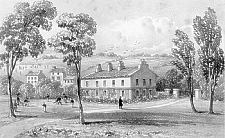
Oakhill School, from A Six Days' Tour, 1836

Oakhill School, from A
Six Days' Tour, 1836
Originally Cronk (or Knock) Bane (White Hill), the name was anglicized by Captain Edward Forbes in 1798 - it may have him who built the house shown above. Forbes' son, also Edward was a banker and father of Edward Forbes the naturalist; Forbes senior was certainly issuing card money by 1812 as 'E Forbes, Douglas' and was one of the five who applied for bank licences in 1817 so it may be that he moved to Douglas c.1812.
In 1812 owned by John Bell, who also ran several Douglas Herring Houses; after his death in September 1829 the house was acquired by Rev B Philpott who had been apointed Chaplain of St George's in 1828 and was looking for a larger house for his family. Philpott left Oakhill in 1832 on being appointed Archdeacon and rector of Andreas.
For a brief period it was let to Sir John Taubman before in 1835/6 being acquired by John Anson Garvin for use as a school. Garvin had opened the Duke Street Academy in 1820 and then joined forces with George Lowe in Atholl Street in1821 before expanding into larger premises there in 1826, which also included a ladies seminary. However this ladies seminary was sold up on the move to Oakhill.
Oak Hill is one of those sweet seclusions you meet with in every country, where the traveller feels disposed to sit down contented with what he has seen, and enjoy life. It has latterly been taken by Mr. Garvin for an academy for gentlemen; a finer situation for an establishment of this nature could not be picked out.J. Welch A Six Days' Tour (Ch 4)
Garvin had educated Edward Forbes jnr, at his Athole St College.
In Quiggin's Guide, 1st edition dating from 1836, is the following advert:
OAK HILL SCHOOL (NEAR DOUGLAS)
A. H. GARVIN, A.M., MASTER,
For young Gentlemen under 11 years of age
21 Guineas per Annum.
Ditto between 11 and 14 do
25
Ditto above 14
30
The above terms include not only instruction in the practical mathematics and all the branches necessary to qualify either for the Military or Naval Colleges, the Universities or Public Offices, but also washing and extras, stationary excepted separate beds are provided.
Like most private schools on the Island it was shortlived - Garvin left the Island in 1840.
In 1851 occupied by Thomas Jones and his unmarried brother and sisters
In 1863 occupied by Robert,Crossfield gent. and also a Mr. Wm Daniels
The house shown on Welch's view of 1836 was severely damaged in a fire later in the 19th century and was rebuilt.
Hinton Bird The Island that led - The History of Manx Education vol 1 pp164 (see page on Education)
|
|
||
|
|
||
|
Any comments, errors or omissions
gratefully received The
Editor |
||